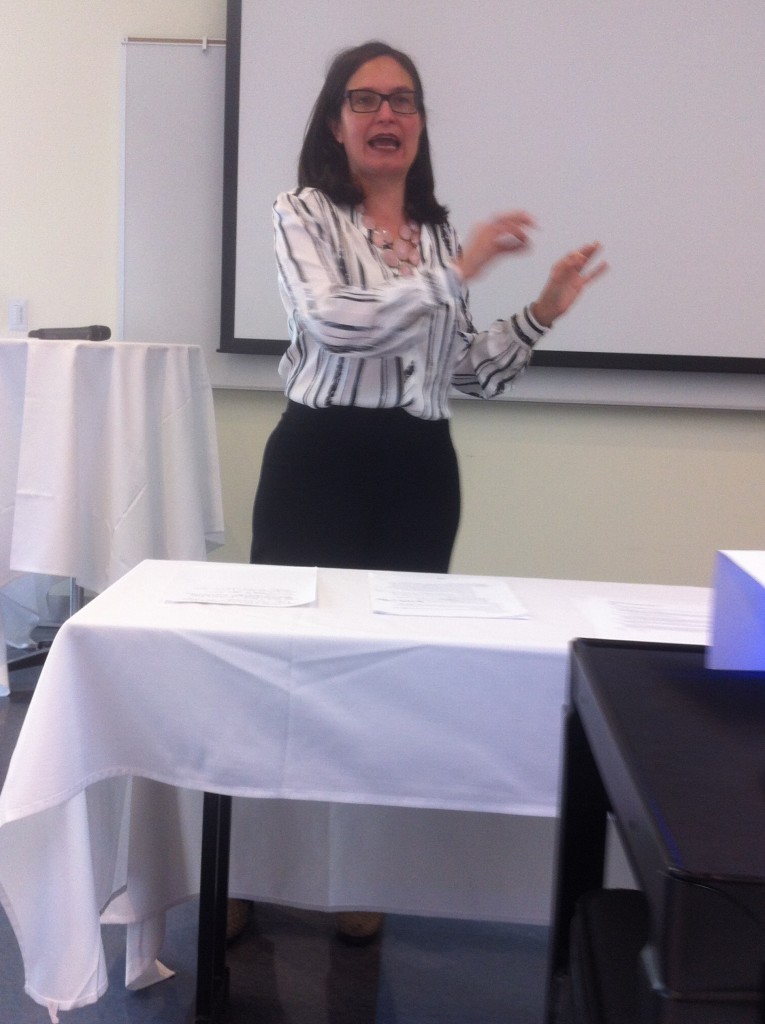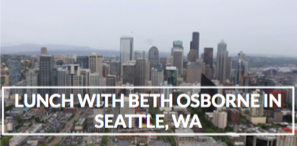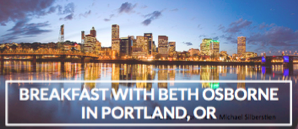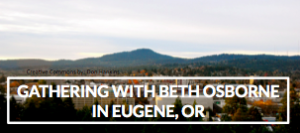Dear T4America members,
USDOT is now seeking applications for a ninth round of TIGER grants. USDOT will be awarding a total of $500 million on a competitive basis to transportation projects that “will have a significant impact on the Nation, a metropolitan area, or a region.” While T4America fights for the continued existence of the TIGER program in 2018 and beyond, we wanted to share four quick things about this ninth round of TIGER grants as you consider applying:
1) There’s no need to rethink your existing projects or recast them for the new administration. It may be a surprise, but USDOT is using the same criteria for this round that they were using under President Obama in 2016. If you have a project you think is competitive or have submitted for recent rounds, don’t recast the project or rework the application expecting the criteria to be drastically different.
The one change was an inclusion of a rural focus, but even that emphasizes the typical goals of TIGER: “improved access to reliable, safe, and affordable transportation for communities in rural areas, such as projects that improve infrastructure condition, address public health and safety, promote regional connectivity, or facilitate economic growth or competitiveness.” And though unspoken in this notice of funding, USDOT and the Trump administration have put a big emphasis on public-private partnerships, which surely would be welcomed in the TIGER program as well.
2) Get your applications in quick. Another reason to avoid trying to recast a project or come up with a brand new project is that applications are due very soon. Unlike past rounds with as much as three months to prepare applications, there’s just a little over a month to submit your applications for consideration by October 16th. Therefore, you should choose a project that has a firm scope, budget and partners in order to get those applications in by the deadline.
3) Broad support will be vital. While the criteria may not have changed, the administration is likely to respond better to projects that have the broadest support from other local, state and federal elected leaders as well as business and civic leaders from you area. If you don’t have your congressional delegation on board, set up meetings as soon as possible to garner their support. Ask them to write supportive letters to USDOT and include your project as a topic of conversation at meetings with USDOT and other administration representatives. Having a broad bench of support from all levels of government for their project can have a positive impact on your project’s likelihood of winning an award. Why should USDOT select a project that’s not even supported by all the stakeholders?
4) Don’t forget, members can tap our expertise. As a benefit of membership, you can get free advice and staff time from T4America to answer questions about your application and help you submit the strongest application possible. Please don’t hesitate to get in touch with us, which you can do through outreach director Ranata Reeder: ranata.reeder@t4america.org
We wish you all the best of luck. And we hope to have good news about preserving funding for TIGER in 2018, though we’ll be counting on your continued support and advocacy to buttress those efforts in Congress over the next month or two.
Beth Osborne
Interim Director
Tag: beth osborne
Talking about transportation in the Trump administration with the “CodCast”
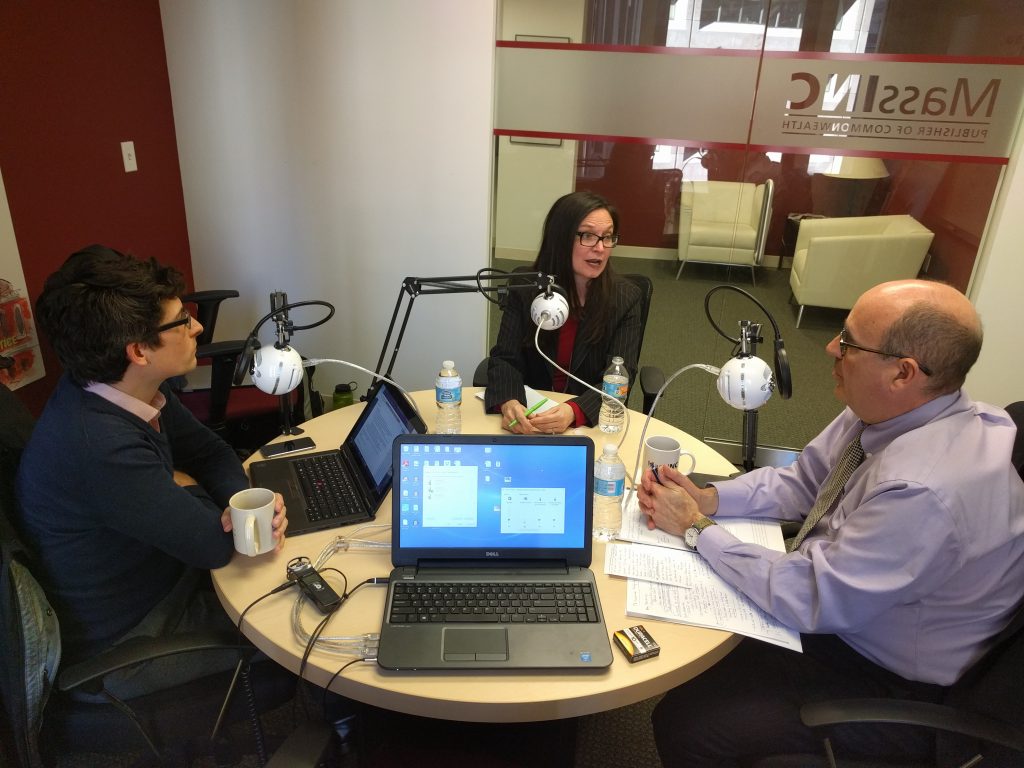
Beth Osborne, senior policy advisor for T4America, sat for an interview last week on one of the best-named podcasts around — The CodCast — to talk about the uncertainty of just what transportation means in the Trump administration.
As you may have seen on Twitter last week, a contingent of T4America staffers were in Boston last week to discuss transportation needs with state officials and policy advocates. While there, Beth sat down with Transit Matters board members Josh Fairchild and James Aloisi on Commonwealth Magazine’s Codcast (yes, the CodCast!) to talk about Trump’s ongoing promises for a $1 trillion infrastructure program, how his now-released budget reflects his true priorities and what advocates need to know going forward in an era with great uncertainty about federal transportation funding.
Listen to the full show below.

Do our federal transportation priorities match the rhetoric we use to justify more spending?
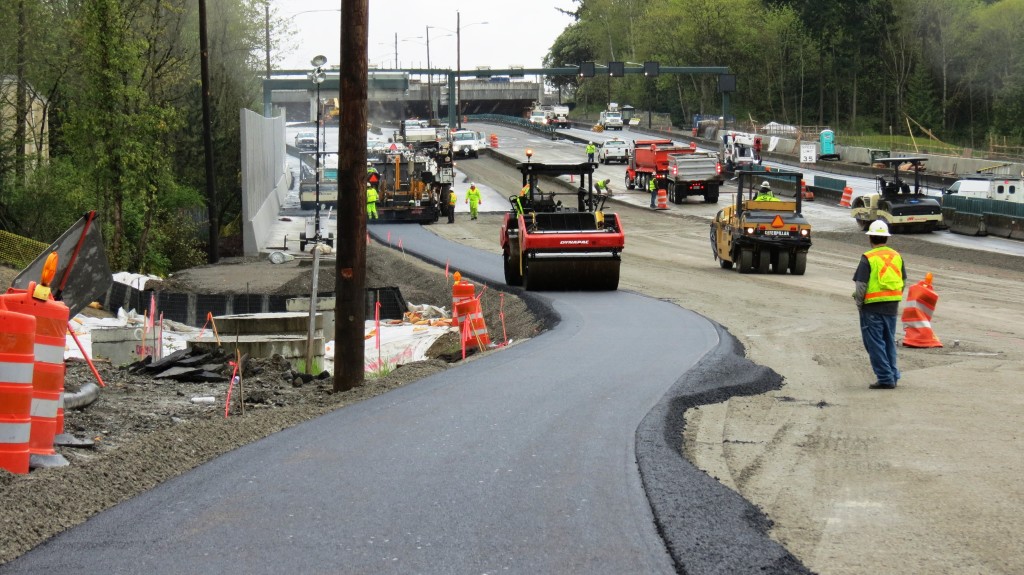
With the Trump administration readying both an annual budget and discussing a possible large infrastructure package, Transportation for America yesterday urged a key Senate subcommittee to protect the investments in programs that promote innovation, encourage collaboration and maximize benefits for local communities.
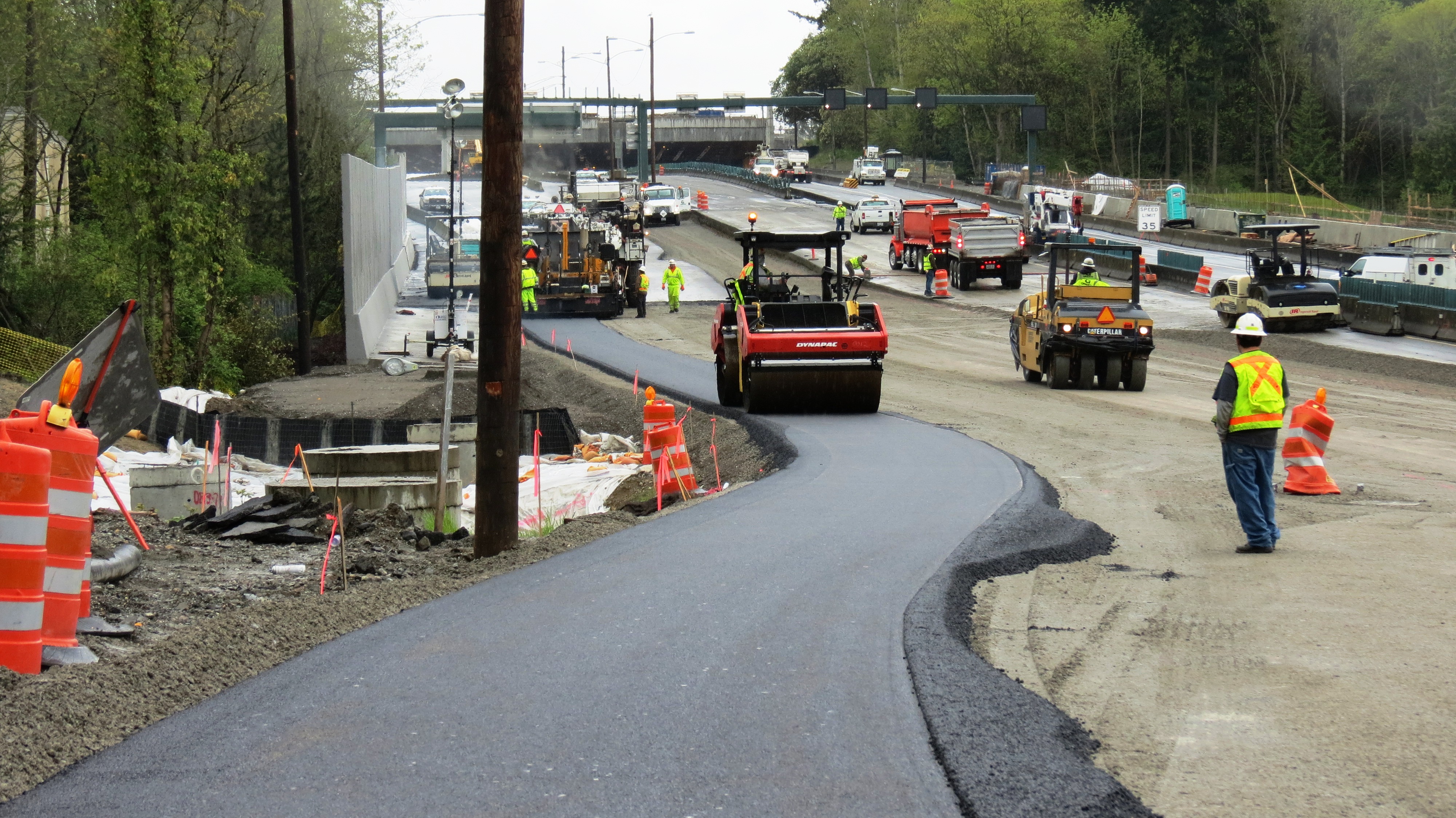
The President’s first budget will almost certainly propose big cuts to discretionary spending programs. While the bulk of annual federal transportation spending is sourced from the highway trust fund and should be more insulated from these cuts, discretionary cuts would fall disproportionately on funding for new transit construction (New and Small Starts) and multimodal and local priority projects (TIGER).
House and Senate appropriators will have two decisions to make: a) whether to appropriate the amounts prescribed by the current long-term transportation law (the FAST Act) for the core programs, which is uncertain as well, and, b) how much to allocate for these other discretionary transportation programs.
As expected, with the heads of a few national trade groups also testifying yesterday alongside T4America before the Senate Appropriations Subcommittee on Transportation, Housing and Urban Development, there was the usual rhetoric about America’s “crumbling” infrastructure amidst calls to invest more money overall in the federal transportation program.
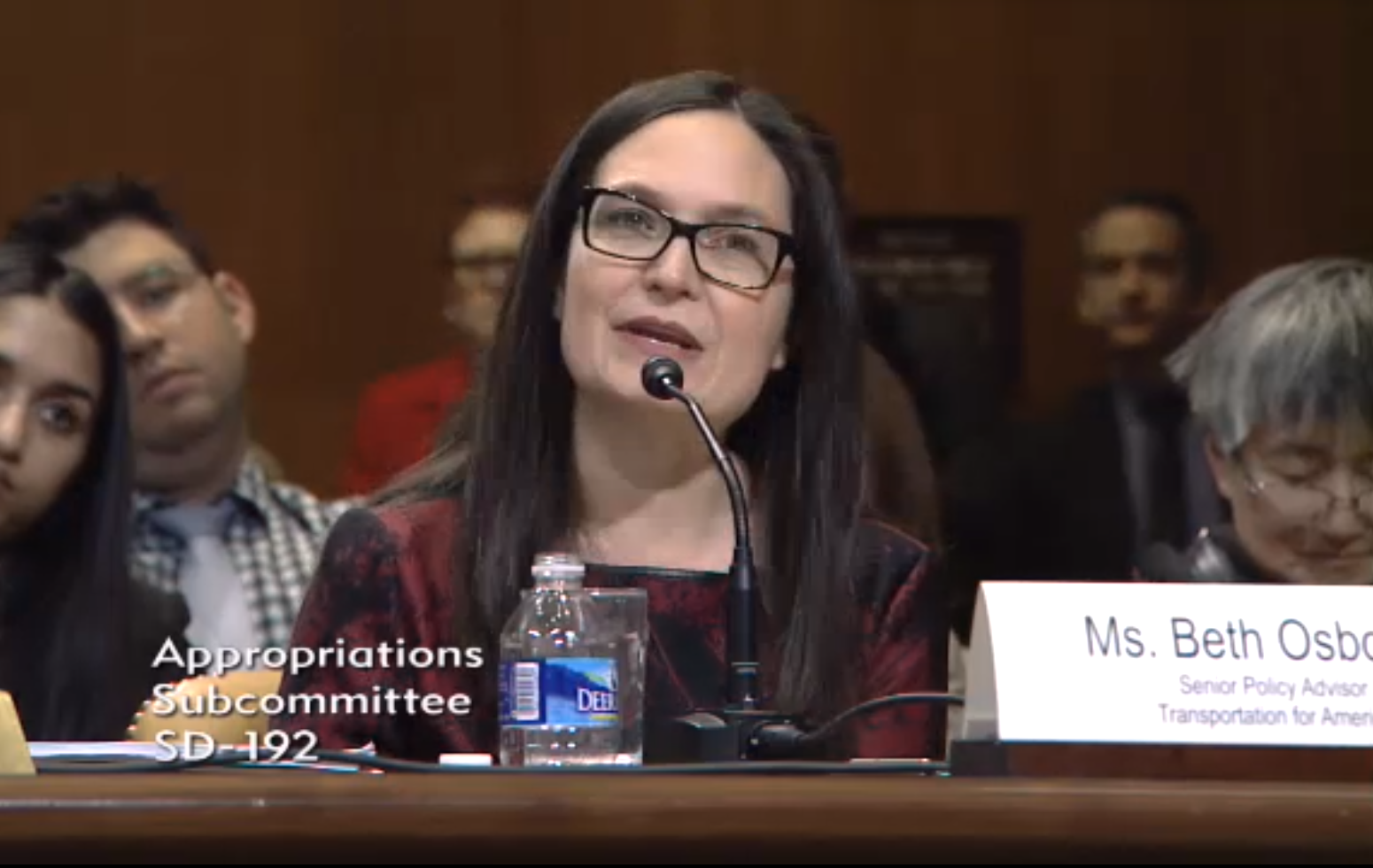
And while T4America agrees on the need for greater levels of overall investment, T4A senior policy advisor Beth Osborne (pictured above) differentiated our overall position.
“As everyone testifying today will say,” she noted in her opening remarks, “we have great need to invest in our transportation system, including our roads, bridges, and transit systems. However, Transportation for America also believes that our problems run far deeper than just an overall lack of funding.”
When we have these discussions about the need to invest in infrastructure — especially in Washington — all sorts of ominous numbers are thrown around. Tens of thousands of deficient bridges. Pavement condition that’s worsening by the day. Backlogs of neglected maintenance and repair.
But where does the money go once we increase transportation spending and dole it all out to the states? Beth Osborne explained:
In fact, while we talk about the need for more funding to address our crumbling infrastructure, that is not necessarily where the funding goes. A 2014 report conducted by Smart Growth America called “Repair Priorities” found that between 2009 and 2011 states collectively spent $20.4 billion annually to build new roadways and add lanes. During that same time, states spent just $16.5 billion annually repairing and preserving the existing system, even while roads across the country were deteriorating. As we talk about large infrastructure packages, it’s only fair to ask that the priorities of our transportation program more closely match the rhetoric we use to justify more spending on it.
Why do we keep spending hefty sums on new roads and new lanes while repair backlogs get ignored? One reason is that transportation and development decisions are rarely well coordinated and we end up trying to address bad land use decisions with more transportation spending, and vice versa.
More from Beth:
I think about the two houses in Florida that are 70 feet apart but require a seven-mile drive to get from one to the other. Such a roadway and land use pattern seems almost designed with the express purpose of generating traffic snarls. But the problem is not categorized as a development or local road connectivity problem. It is put to the state and the federal government as a congestion problem that requires big spending to widen roads. Now no one is calling for the federal government to get involved in local land use decisions. However, there should be a way to reward cities and states consider these and take action improve outcomes and lower costs. Competitive programs can help to do that.
One of those competitive programs is the TIGER grant program, which could be one of the programs targeted for severe cuts — or elimination — in this looming budget proposal from the President.
TIGER has awarded more than $4 billion since 2010 to smart local projects, bringing 3.5 local dollars to the table for every federal dollar through just the first five rounds. Though only 5-6 percent of all applicants have successfully won funding, local leaders still love the programs, and the process encouraged applicants to try new strategies or approaches to be as competitive as possible to win funding — “like design-build project delivery or complete street designs or public-private partnerships,” Beth noted.
Rather than just sidling up to the table for their share of dollars allocated by some federal formula, communities have been trying to produce the best, most competitive applications that will bring the highest returns on both the federal investment and their local commitment.
This is the kind of innovation that Congress should be encouraging, not targeting for cuts.
In the New and Small Starts transit capital programs, there’s over $6 billion already promised to shovel-ready transit projects all across the country that have already raised local or state funding and are just waiting on capital dollars from the federal government to proceed. Projects like Indianapolis’ Red Line bus rapid transit project that has already been promised more than $70 million in federal dollars to pair with nearly $20 million in local funds from an income tax increase that Indianapolis voters approved back in November at the ballot box.
Indianapolis and a multitude of other communities small and large “are stretching themselves to raise their own funds and to innovate, but they cannot bring these important projects to fruition without a strong federal funding partner,” Beth said in closing this morning. “The programs that this committee funds are often the lynchpin for aiding states and localities in meeting these demands.”
We hope that this Senate subcommittee heard the message loud and clear and will stand up for these vital programs as the budget process moves forward. We’ll keep you updated.
Unpacking the final suite of new USDOT performance measures [video]
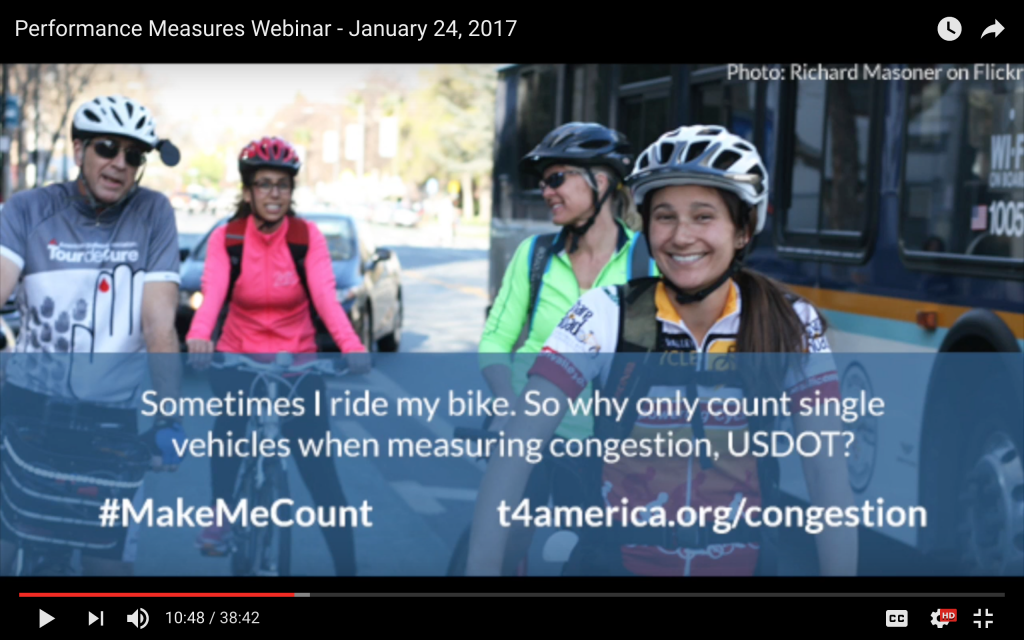
The new requirements released last week by USDOT for how states and metro areas will have to measure traffic congestion were just part of a larger package of all-new performance measures. Catch up on what you need to know about them with our detailed webinar unpacking all of it.
Many thanks to our Beth Osborne for sharing her knowledge and wisdom about performance measures with us on this helpful session. FHWA was unable to participate due to the regulatory freeze now in place preventing federal agencies from communicating further about any new regulations in process or not yet completely finalized, but we were able to roll on ahead. (2:20)
The 2012 transportation law (MAP-21) required transportation agencies to begin using a new system of performance measures to govern how federal dollars are spent. USDOT’s final rule for measuring traffic congestion was just one part of a much larger package of new performance measures, including measures for safety, the state of repair, congestion, air emissions and other aspects of our transportation system. (4:00)
On this webinar, we walked through the last of three final rules that cover road, bridge and pavement condition, and overall system performance. We discussed what’s missing in the new measures (8:00), what changes we asked for along the way (10:30), what comprises the final package of rules (15:20), the changes made to the final package (18:05), the dates that states and metro areas will need to be aware of over the next year (18:50), some other helpful resources from T4America and others (20:20) and answered a handful of really smart questions from those who participated (24:00).
More about performance measures
How can we reinvigorate and refocus our country’s transportation program?
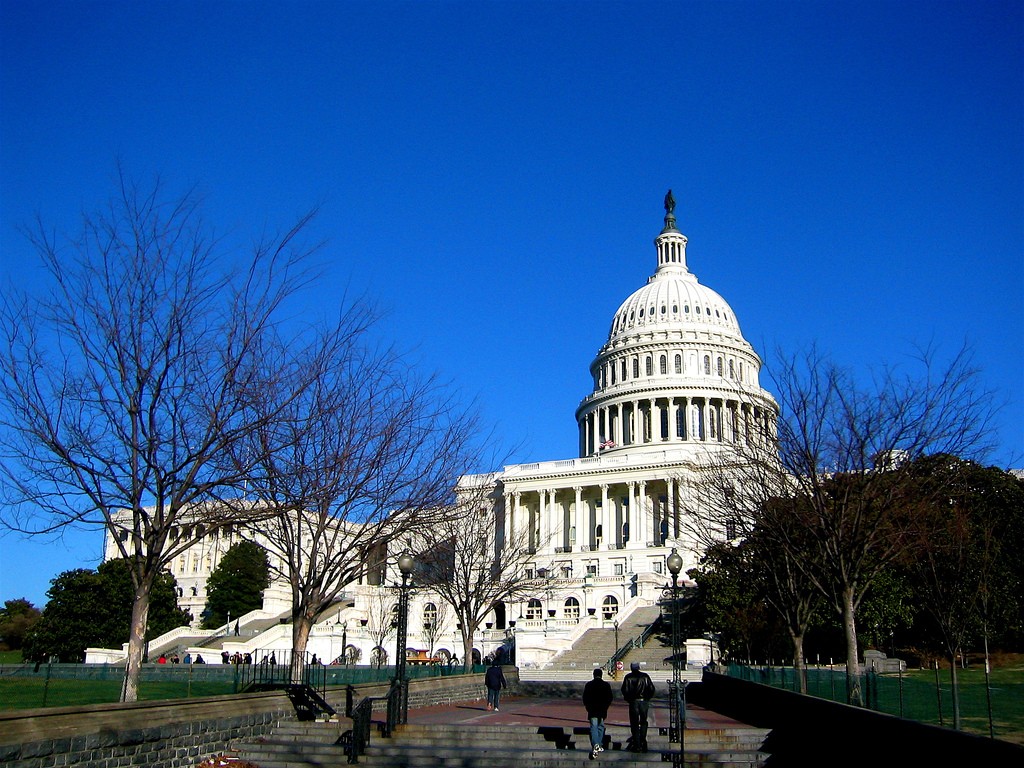
Though the FAST Act is just six months into its five-year lifespan, it’s never too early to start discussing how to overhaul the outdated priorities of our nation’s transportation policy — especially when Congress failed to address them in that five-year transportation bill. One of our experts was a featured guest in a congressional briefing intended to move that conversation along.
Beth Osborne, senior transportation advisor for T4America, discussed these ideas at a short briefing on Capitol Hill entitled New Vision, Principles and Funding to Reinvigorate the Transportation Program, organized by Senator Tom Carper (D-DE) and Rep. Earl Blumenauer (D-OR).
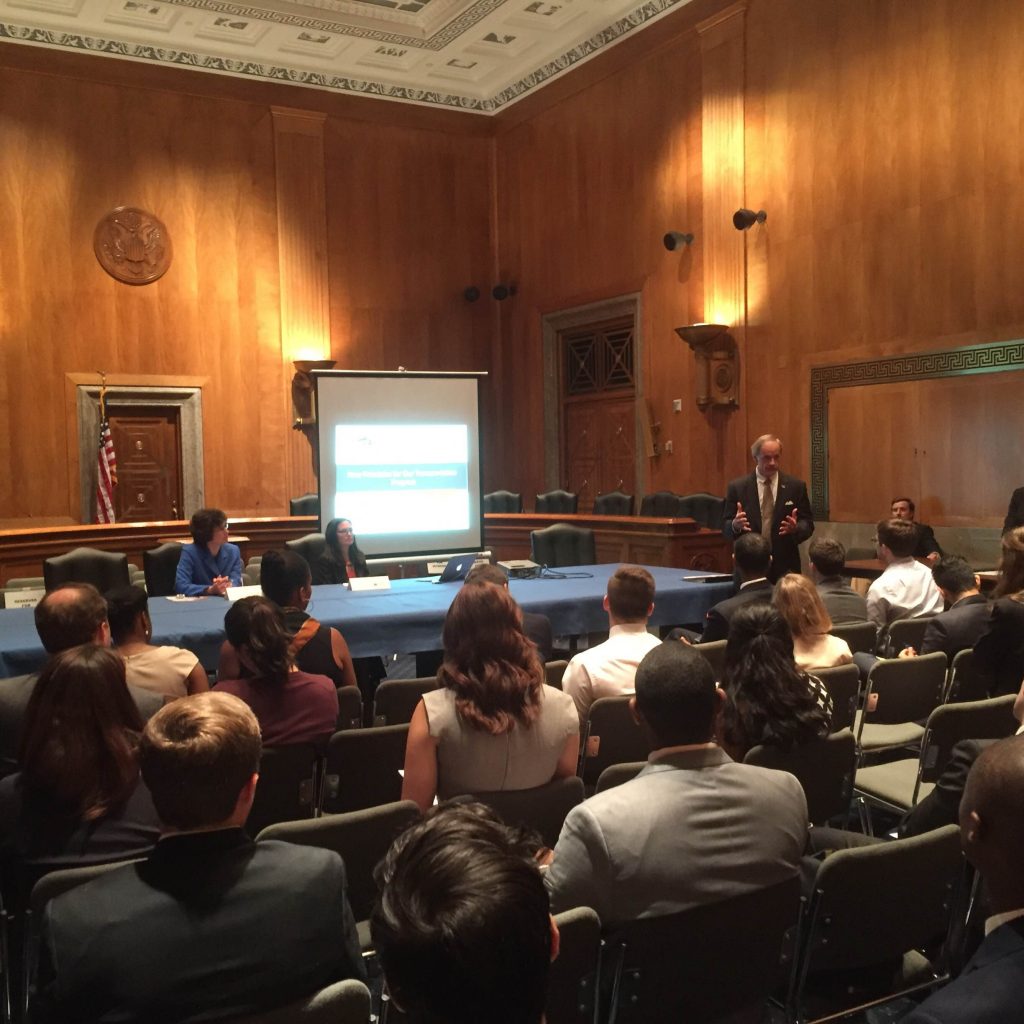
Senator Carper introducing the briefing on Wednesday, June 15th.
We hear a lot about how the gas tax has lost its value and we need to find ways to increase funding for our country’s transportation system. While this is all true, we also must use our existing resources far better.
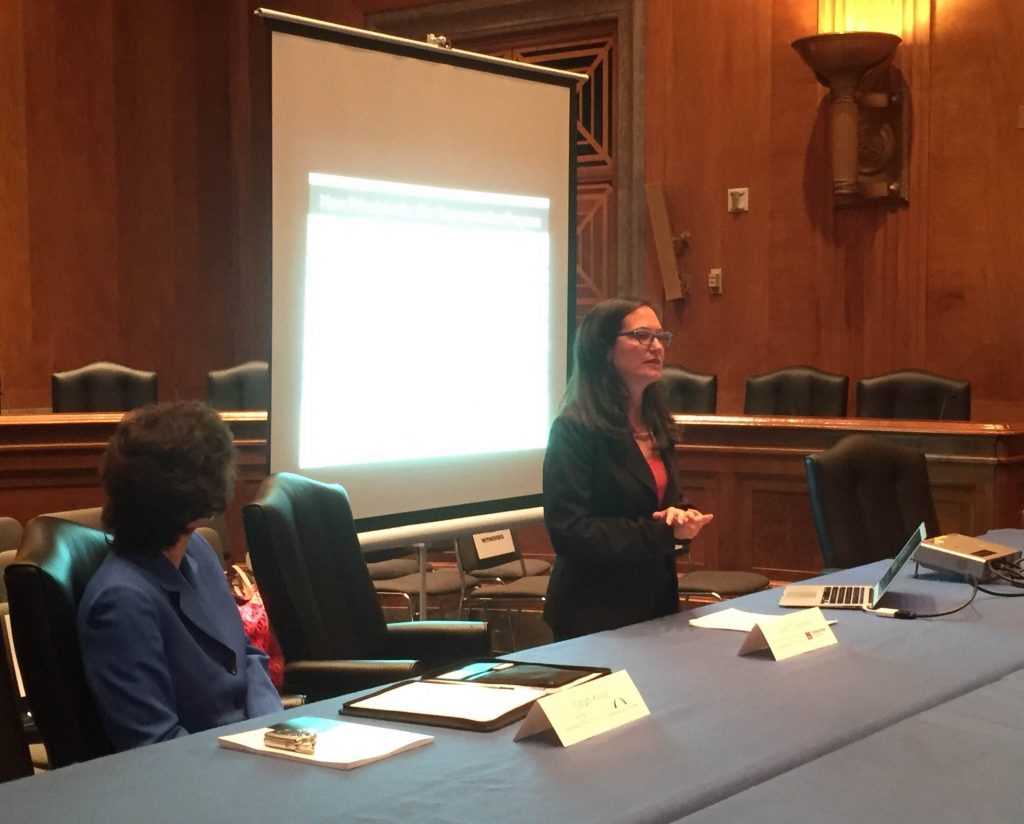
Beth Osborne presenting at the briefing
In New Principles for Our Transportation Program, a report Beth Osborne recently penned for The Century Foundation, she laid out four key changes we should make, which she presented in yesterday’s hearing: fix what we have first, focus on moving people and goods instead of vehicles, use competition to spur innovation, and come up with an honest way to fund transportation that doesn’t depend on general tax dollars to shore up an outdated, broken funding mechanism.
While a lot in Congress point to the need for more funding, “there is a lot that is not understood about the problem,” Beth suggested.
“There’s a disconnect between the policy, programs and the way the money is spent.” When faced with a funding shortfall, rather than assessing how bad development decisions drive the need for further transportation investments, Beth asked the crowd while referring to the map below, “is this really a funding problem or a planning problem we [federal government] are being asked to pay for?” she asked.
Denham Springs, LA, where even a short trip requires a car
One way to spend money more wisely is to find ways to award it to the best projects, rather than formulas that spread money around like peanut butter across states, regardless of need or merit, funding as many (if not more) ill-conceived projects as wise ones.
“Competition in TIGER and other programs provide a great incentive for bringing in the best possible projects and generating innovation,” she said. “But more competitive funding programs and better measures of success are needed.”
Private investment and more public-private partnerships have been regularly invoked by members of Congress across the political spectrum as solutions to the funding shortfall for transportation, but why don’t we see more public-private partnerships (P3s), and how can local communities ensure they’re getting a good deal?
Beth was joined in the briefing by T4America alumnus Sarah Kline, who just wrote a paper for the Bipartisan Policy Center showcasing practical solutions that can get support from both parties, focusing also on what the private sector can do to meet more of America’s infrastructure needs.
One suggestion was that projects need to have a clear statement of public benefit before receiving any public funds — what should the public expect to receive for their investment? Projects also need a full accounting of life-cycle costs. Whether a P3 or not, too many municipalities have a solid plan for upfront costs and aren’t prepared for maintenance or operation costs with projects down the road.
We were grateful to be invited to speak by Rep. Blumenauer and Sen. Carper and look forward to continuing this incredibly important debate.
Interested in learning more about or applying for this year’s TIGER grants? Join us on 3/24
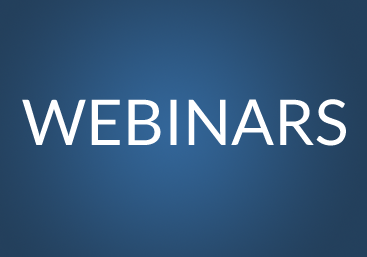
Though the future of the program is perpetually up in the air, $500 million in competitive federal funding is available for smart, local transportation projects this year in the TIGER program, and Transportation for America is here to help you learn more about the program.
Is your community interested in applying for a TIGER transportation grant? Are you looking for help and support in preparing the best possible grant application?
The fiercely competitive TIGER program is one of the few ways that local communities of almost any size can directly receive federal dollars for their priority transportation projects. Projects vying for funding compete against each other on their merits to ensure that each dollar is spent in the most effective way possible, spurring innovation, stretching federal transportation dollars further than in conventional formula programs, and awarding funding to projects with a high-return on investment.
But the program is, as stated above, fiercely competitive. Over the life of the program, the requests for funding have been 50 times greater than what’s been available. There are far more losers than there are winners in the TIGER program. Being prepared with the best possible project and application is key to winning, and T4America can help.
Join us for a free, public webinar on Thursday March 24 at 4 p.m. EST on the latest round of TIGER funding with some pointers from T4America senior policy advisor and USDOT veteran Beth Osborne, and Smart Growth America director of research Michael Rodriguez on how to win funding for your project.
The webinar itself will cover what makes applications competitive, what USDOT has been looking for throughout the program’s seven rounds so far, the role of the benefit-cost analysis, the importance of the non-federal match (i.e., local dollars brought to the table), how shovel-ready a project needs to be, the importance of support from local elected officials, and typical mistakes to avoid, among other helpful areas of interest.
During this discussion, we’ll also have information about T4America’s technical assistance offerings and opportunities for professional consulting on your project. Our technical assistance program can actually help with grant application writing, review, and drafting of the benefit-cost analysis. We can also provide detailed advice and valuable insight into the TIGER process for those that might just want more details than a webinar would provide.
Benefits for T4America members
T4America members also have the option of receiving limited free technical assistance for TIGER. Logged-in members will see information about that below. Interested in joining as a T4America member? Find out more information here.
[member_content]Transportation for America members interested in applying for TIGER receive the option of an hour with Beth Osborne to walk through your project and talk about strategy for their application. If you’re interested in scheduling this, get in touch with Erika Young at erika.young@t4america.org or 202-955-5543 x239[/member_content]
Though the program’s future is uncertain, $500 million in TIGER grants are now available
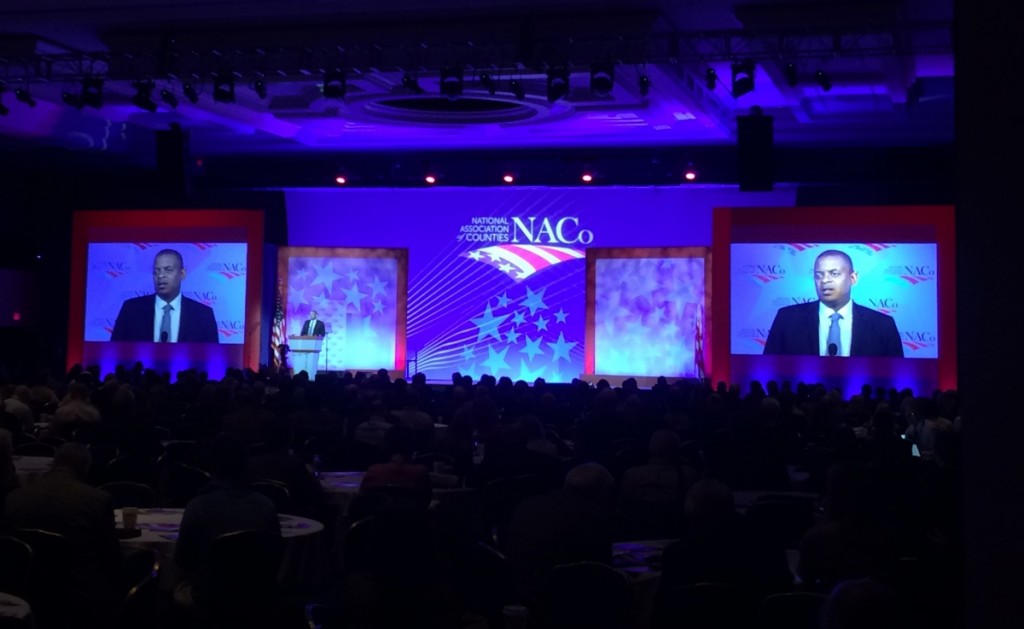
Though the future of the program could be in doubt, U.S. Transportation Secretary Anthony Foxx announced yesterday that $500 million is now available for the best local projects in the next round of the TIGER competitive grant program.

Sec. Foxx making the TIGER announcement at the NACO conference. Photo from the USDOT Fast Lane blog.
Projects hoping to win TIGER funds compete against each other and are selected on their merits to ensure that each dollar is spent in the most effective way possible. The program has funded an incredible multimodal station in Normal, Illinois, an overhaul of the downtown street network in Dubuque, IA that helped expand the tax base by $77 million and an improvement to the West Memphis port to boost cargo capacity by 2,000 percent, among hundreds of others.
It’s one of the few ways that local communities of almost any size can directly receive federal dollars for their priority transportation project, spurring innovation, leveraging federal funding by matching it with greater local dollars and targeting projects that provide a high return on investment.
The program is open and available, with grant applications due on April 29th.
We’ve got a special members-only webinar coming up on March 3rd with our TIGER grant expert Beth Osborne, T4A’s Senior Policy Advisor. T4America members can find a link to register below.
[member_content]Members: Interested in applying for this round of TIGER grants? Join T4A and TIGER grant expert Beth Osborne, T4A’s Senior Policy Advisor, for an informative session on March 3, 2016 at 4pm EST. Register here. [/member_content]
While this eighth round of TIGER is open for business now, will there be a ninth? Don’t forget that congressional appropriators will soon be deciding TIGER’s future, along with that of other important transportation programs. Do you represent a city, county, metro planning organization, or other group? We’re looking for these sorts of groups to sign a letter to the Senate Appropriations Committee in support of these programs.
Effectively linking transportation with economic development: Beth Osborne visits the Pacific Northwest
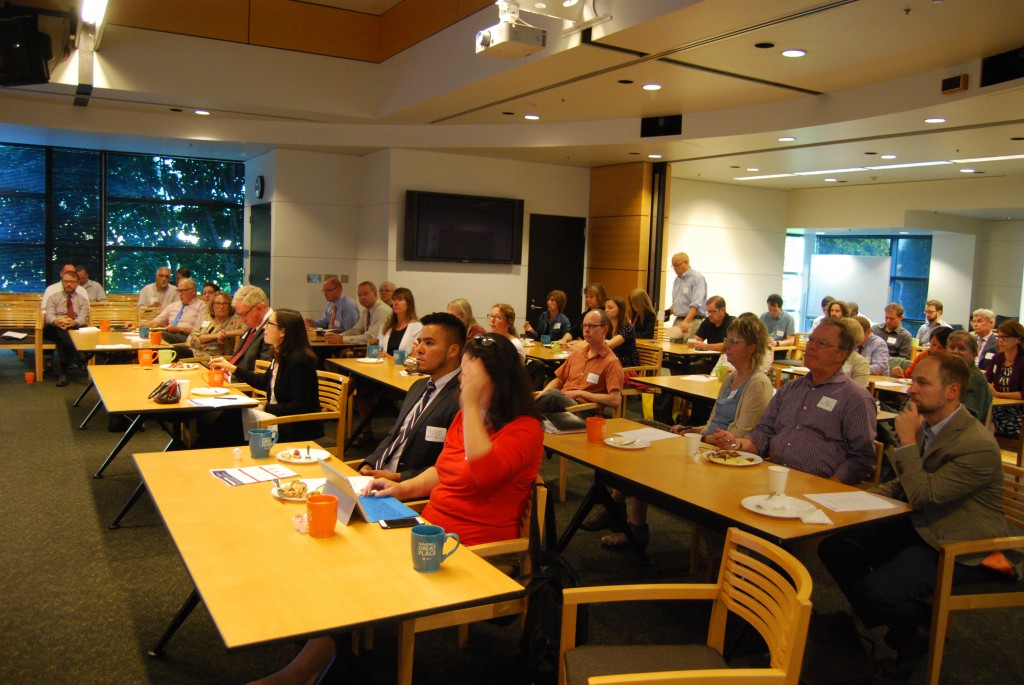
On September 10 and 11, T4A brought Senior Policy Advisor Beth Osborne to the Pacific Northwest to speak with audiences in Seattle, Portland and Eugene about the links between transportation investment and economic development. There are countless examples of these links in each city, and local speakers shared those stories at all three events.

A good crowd gathered at Metro’s policy breakfast with Beth Osborne in Portland.
This November, Seattle voters will decide whether to support the Move Seattle levy, an ambitious plan to invest in five bus rapid transit (BRT) lines and a range of complete streets projects to improve Seattleites’ mobility and safety by updating the design of city streets to better match the demands being placed on them by a greater range of users. Mayor Murray’s transportation policy director Andrew Glass-Hastings was there to share details on that effort. (The City of Seattle is a T4A member.)
The Portland event was hosted by Metro, another T4A member. Years of hard work have come to fruition with both the Portland Milwaukie Light Rail (PMLR) line and Tilikum Crossing over the Willamette River opening immediately after the event on September 12, and the region is hard at work planning a Bus Rapid Transit line from Portland to Gresham. (Both cities are members of T4A as is TriMet, the region’s transit district.) Brian Newman from Oregon Health & Science University shared the story of the hundreds of millions of dollars of current and planned economic development in the South Waterfront spurred by the new light rail line, streetcar, the aerial tram and TIGER-funded improvements to S.W. Moody Avenue. Duncan Hwang from the Jade business district spoke about their efforts to minimize or prevent displacement of disadvantaged communities when the Powell Division BRT line is built in the next 5 years.
The third event was in Eugene, where the neighboring city of Springfield (another T4A member) has a TIGER application in for streetscape improvements on Franklin Boulevard that could spark substantial infill development — including new hotels to serve the visitors at the 2021 World Track Championships hosted by the region. Springfield Mayor Christine Lundberg shared those aspirations, and Eugene Mayor Kitty Piercy, Eugene Area Chamber of Commerce president Dave Hauser and PIVOT Architecture principal Kari Turner all testified to how Eugene-Springfield’s growing regional BRT network is part of their economic development strategy. In fact, T4A member Lane Transit District received federal Small Starts funding for its West EmX BRT project on the same day as our event in Eugene.
The local stories at all three events helped provide context for Beth’s Ms. Osborne’s message: if your region wants to get the best economic development results from transportation investments, it’s imperative to carefully measure the outcomes against your region’s values. Measure outcomes like congestion the wrong way, and you could be inhibiting economic development in favor of moving cars around quickly for no economic gain.
Referencing a series of recent T4America and Smart Growth America reports – Measuring What We Value, Core Values, The Innovative MPO – Ms. Osborne pointed to new approaches yielding better results.
These recent events are sparking productive conversations in each region. Interested in organizing an event like these in your area for members and non-members? Get in touch with us and feel free to share ideas for topics and speakers.
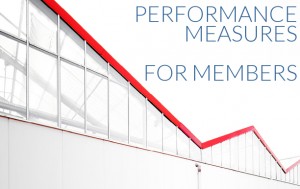 Relatedly to the topic of measuring outcomes, don’t miss Beth’s ongoing series on performance measures, available only for members.
Relatedly to the topic of measuring outcomes, don’t miss Beth’s ongoing series on performance measures, available only for members.
Feel a little lost when it comes to the concept of transportation performance measures? In this short series expressly for T4A members, our resident expert and USDOT veteran will help bring you up to speed on an issue that’s complicated but represents a smart way forward on transportation planning and spending. Read more.
Join T4A’s Beth Osborne in Portland and Seattle next week for talks on transportation and economic development
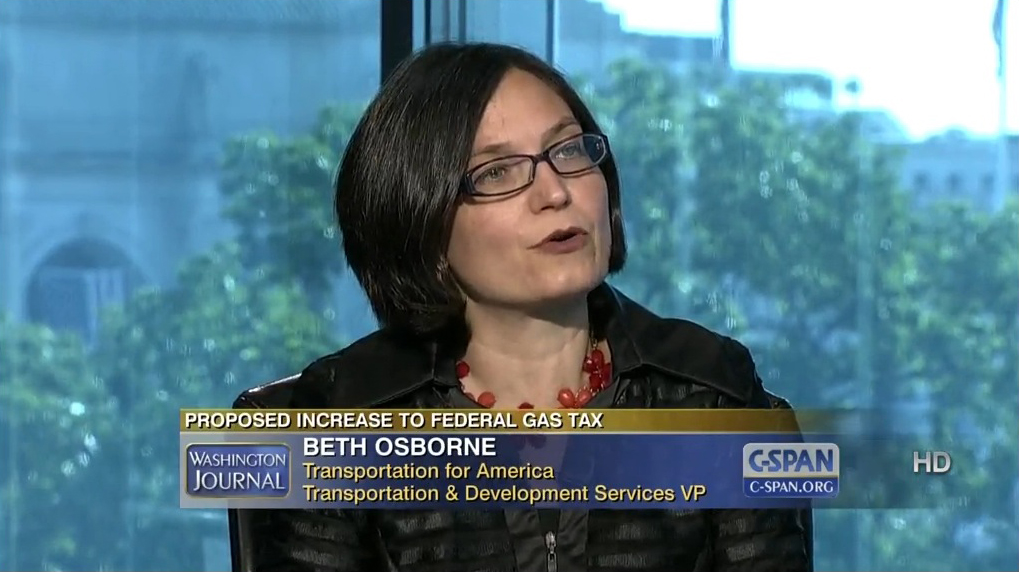
Beth Osborne, Transportation for America’s senior policy advisor, is making three stops in the Pacific Northwest soon to discuss how investing in transportation can help drive economic development.
The three sessions will focus on how we can plan and develop our roads, transit systems and freight networks to bring the best possible economic returns. You will learn how regions across the country have made investment decisions and the results they achieved with regard to economic development and competitiveness.
Beth Osborne brings five year’s experience from US DOT, including serving as Acting Assistant Secretary for Transportation Policy, and a national perspective on prospects for improvements to transportation policy and funding. Sign up today. T4America members should have already received a promo code for discounted registration.
Find out more about each session and register with the links below.
T4A’s Beth Osborne Highlights Economic Development in Pacific Northwest Appearances
T4A is pleased to announce upcoming events featuring T4A’s Senior Policy Advisor Beth Osborne in Oregon and Washington September 10th and 11th. Ms. Osborne brings five year’s experience at US DOT – including serving as Acting Assistant Secretary for Transportation Policy – and a national perspective on prospects for improvements to transportation policy and funding.
Osborne and local speakers will discuss economic development implications stemming from how we plan and develop our roads, transit systems and freight networks, and how we might measure success. Come learn how regions across the country have made investment decisions, and what the results they have achieved with regard to economic development and competitiveness. As a benefit of being a T4A member you are able to get discounts on T4A events. To receive a discount on upcoming events enter the promo code: T4A1707 and receive 50% off your tickets.
If you have any trouble with the promo code or have any questions regarding these upcoming events please contact Alicia Orosco at alicia.orosco@t4america.org.
Join us for a discussion on the TIGER grant program and what you need to know before applying
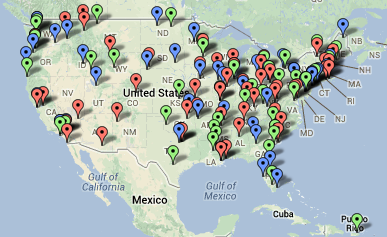
T4America is hosting a webinar this Thursday at 3 p.m. to help municipalities and states interested in applying for this year’s $500 million in grants available in the latest round of TIGER grant funding.
Join us on Thursday, April 23, at 2 p.m. for a discussion with Beth Osborne, T4America’s Senior Policy Advisor, on the ins and outs of the federal TIGER grant program, examples of past winners, and how to best craft a winning application. Communities across the country have benefitted from over $4 billion in grants for innovative, multimodal projects over the last six rounds of funding dating back to February 2010, and you can see them all here on our TIGER map.
Before coming to T4America, Osborne was Deputy Assistant Secretary for Transportation Policy at USDOT, where she ran the TIGER program. Almost no one inside or outside of USDOT knows more about the program or how it works, and she will outline the basic information, show examples of previous winners and share tips you need to put together a smart application.
The 7th round of the TIGER competitive grant application period is currently open, which includes a pre-application deadline of May 4, 2015 and a final application deadline of June 5, 2015.
Register TodayUPDATE: Better bang for the buck — learn more about performance measurement
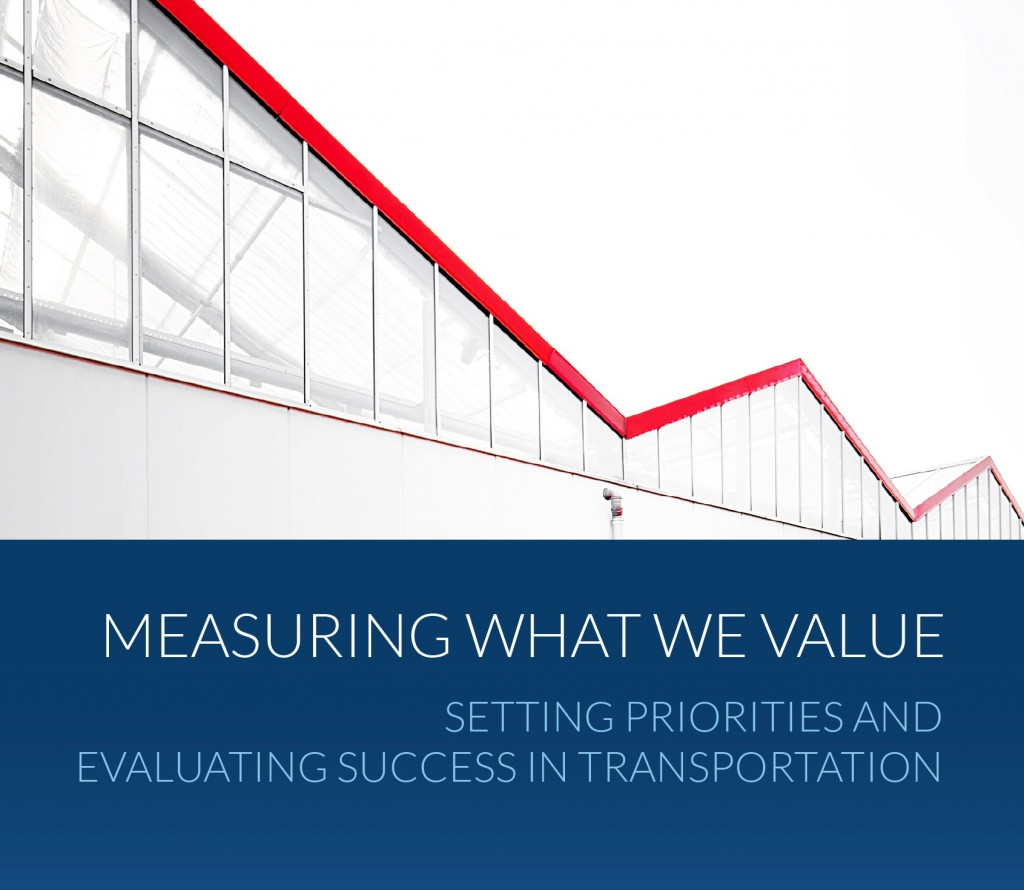
UPDATE 2/18/15: The release webinar has been rescheduled for March 3, 2015 from 3:30-4:30 p.m. EST. The report release and webinar were delayed due to rough winter weather. The registration link is once again active, so go ahead and register today!
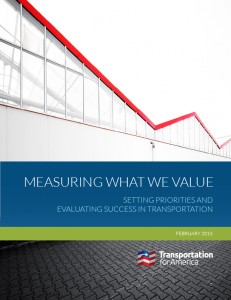 Developing a better system to measure the performance of our transportation spending is an idea that’s gaining momentum, and we want to help you be on the cutting edge.
Developing a better system to measure the performance of our transportation spending is an idea that’s gaining momentum, and we want to help you be on the cutting edge.
On [UPDATED] Tuesday, March 3, Transportation for America is releasing a new report on performance measures called “Measuring What We Value: Setting Priorities and Evaluating Success in Transportation.” To accompany the release and help explain an issue that’s even more wonky than other issues in the world of transportation planning — we’ve organized a helpful webinar on March 3rd from 3:30-4:30 p.m. EST.
We’ll discuss the report, hear experts explain the benefits of measuring the performance of our transportation spending and share some examples of real-world success. Register now.
Those presenting during the webinar include:
- Beth Osborne, Senior Policy Advisor for T4America, formerly Deputy Director for Policy at USDOT.
- Matt Carpenter, Director of Transportation Services, Sacramento Area Council of Governments (SACOG)
- Jim Hubbell, Principal Planner, Mid-America Regional Council (MARC)
- Erika Young, Director of Strategic Partnerships, T4America
Why is this report necessary?
How do we justify transportation expenditures? To many people, the perception is that project decisions are made in a murky, mysterious process, or, even worse, through a political process where only the projects with the most connections get funded. Further, it is not clear to the average person what all the spending gets them. With public confidence in government at low levels, it’s more important than ever to quantify the public benefits of transportation investment and let voters know what their money is going to buy — especially when attempts are being made to raise new money for transportation to fill the gap.
Transitioning to a more performance-based system of transportation investment was one of the key reforms of MAP-21 and could represent a sea change in how funding decisions are made and our transportation system performs.
This report looks at the innovative DOTs and MPOs experiencing early successes in measuring the performance of their transportation system and making investments based on getting the best bang for the buck, and also lays out smart recommended goals and measures from T4America for making this transition.
Click here to be notified about the report’s release on March 3rd and sign-up for our newsletter to stay up-to-date on all report releases.
Northeast Ohio plans ahead for a new network of transportation options
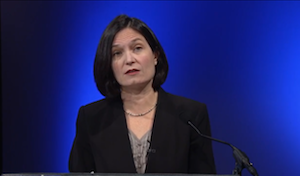
How can a place like the Cleveland region attract and retain talented young people, and how can good transportation options help? That was a core question posed to our Beth Osborne when she was invited to keynote a multimedia event dubbed “Cleveland Connects: Getting Around.”
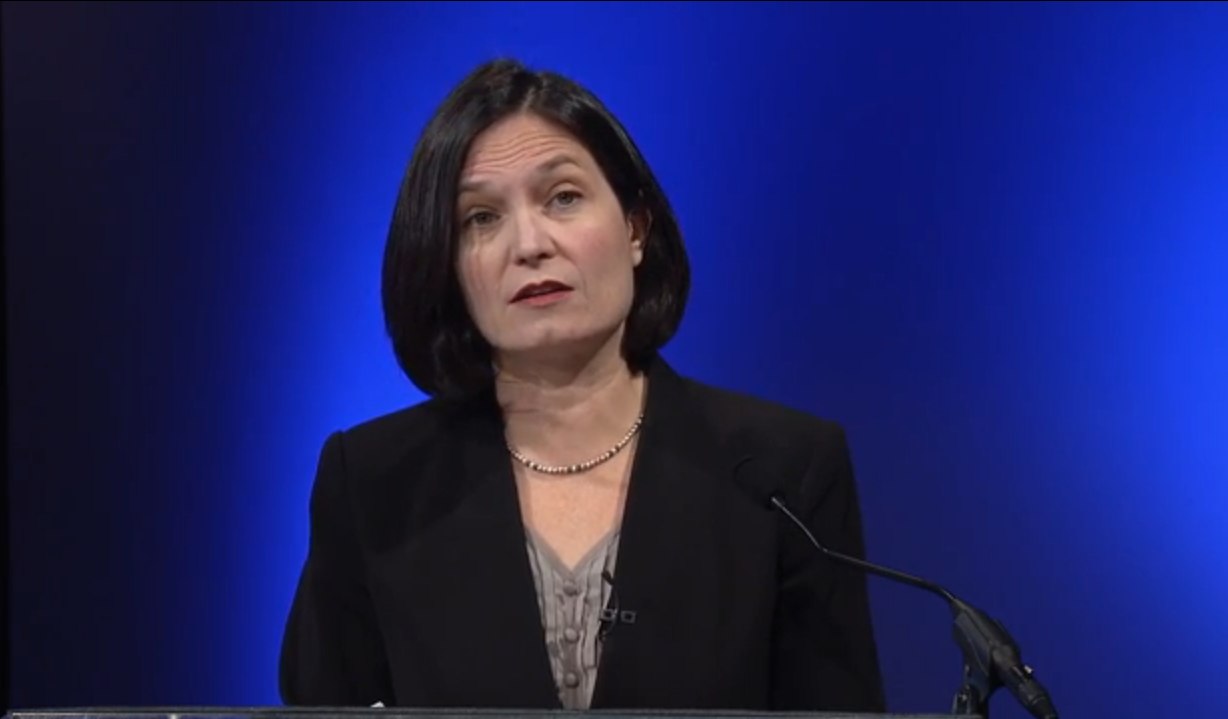 Osborne, T4America’s vice president and senior policy advisor, noted that many younger professionals want to live in cities that offer a variety of transportation options. Many seek walkable neighborhoods that offer everything from restaurants and bars to local grocery stores and schools all within the same half-mile.
Osborne, T4America’s vice president and senior policy advisor, noted that many younger professionals want to live in cities that offer a variety of transportation options. Many seek walkable neighborhoods that offer everything from restaurants and bars to local grocery stores and schools all within the same half-mile.
“When those kids decide they want to go find a job, they actually look for a place they want to live first, and then look for a job, which is a little different than the way people did things when I started looking for work. And that means jobs are following the talent. They’re looking for where the talent locates. And where talent tends to locate these days in places where they can access their needs, and fun, like restaurants and retail and bars on their own two feet. And that is a very different situation from what we had a few decades ago.”
The Nov. 24 event also presented local speakers from across the region and was featured in the Cleveland Plain Dealer and the local NPR affiliate.
Cities and suburbs alike should acknowledge and respond to the big market and demographic changes that are afoot, she said. Chief among them are the dramatic growth in the share of single-person households and the coming wave of empty nesters among the Baby Boom generation.
“Those people have different needs and different desires in terms of transportation. Especially when you look at the younger generation. Many of them weren’t able to get their drivers’ license until they were close to 18 years old.”
While the car still dominates as Cleveland’s main mode of transportation, the region also offers a robust transit system recording an average of two million rides a year — including Cleveland’s popular HealthLine bus rapid transit. The region is considering adding 50 to 100 miles of bicycle lanes and improved bus and streetcar service, but officials are unsure of how to pay for it all when they can barely keep up with the required maintenance and repair.
“We’ve seen people show a great willingness to pay for transportation of all kinds when they have a good understanding of where their funding is going to go and what they’re going to get for it,” Osborne said. “The ballot initiatives for transportation have a success rate that is enviable for any area of over 70 percent, especially when it’s at the local level. Where, like I said, they have a good sense of where that money is going.”
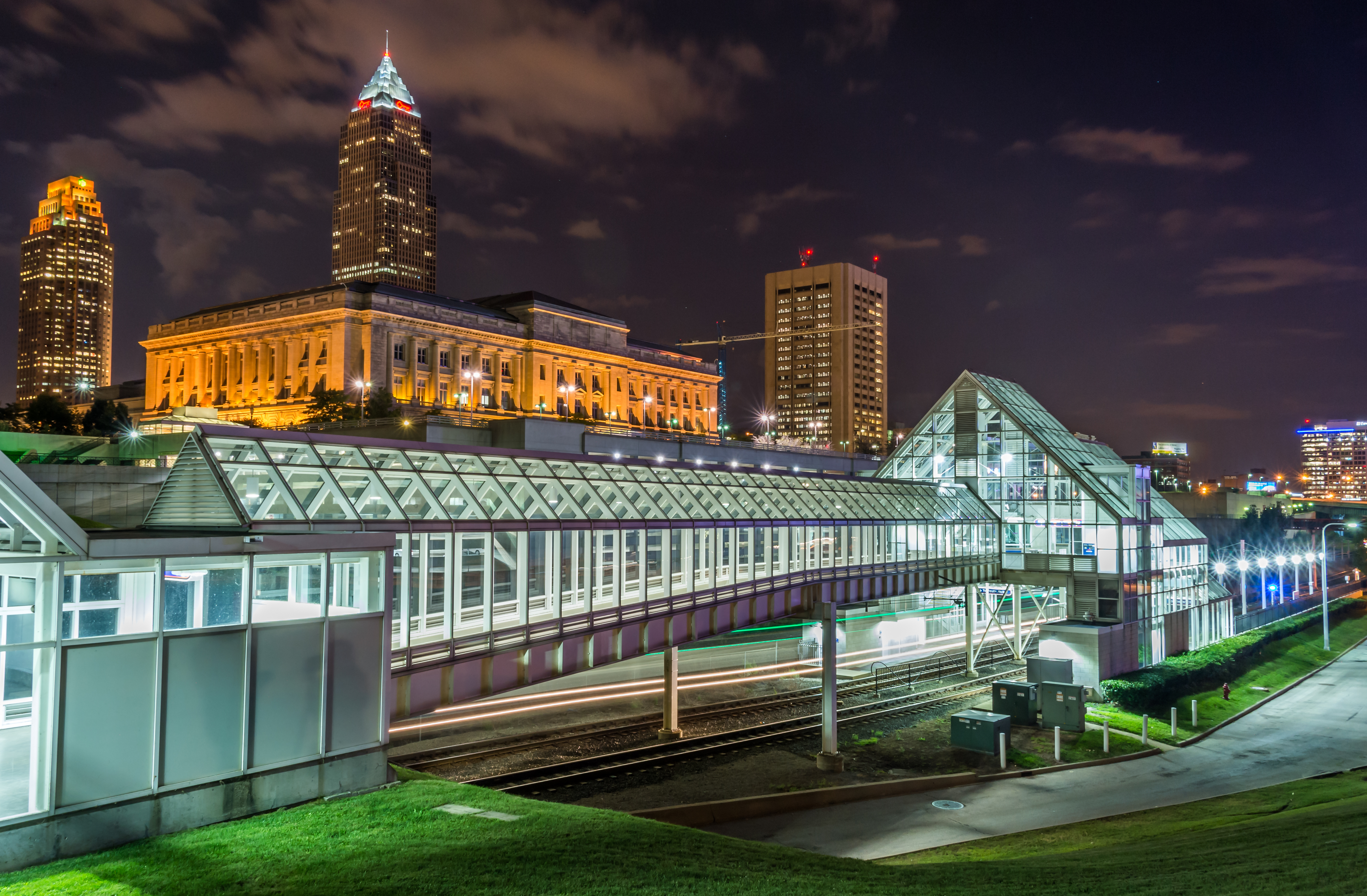
North Shore Station in Downtown Cleveland. Photo credit to Geoff Livingston on Flickr.
Businesses, too, are learning just how profitable being near a transit stop, or in a walkable neighborhood can be. Osborne said her neighborhood in Washington, D.C., is home to one of the most profitable Target stores in the country. However, before Target agreed to build near the Columbia Heights Metro station, the company demanded the city build a “massive parking lot” beneath the store in a garage.
“They didn’t believe that people would go to a Target on foot. … It’s one of the most profitable in the country now, but the parking lot beneath it is empty. And the city is losing millions of dollars a year off of the ownership of an empty parking lot – money that should be going to other infrastructure like our schools.”
Local communities need to decide what works best for them when it comes to planning long term transportation needs and how to best fund them. With people driving less in their own cars in recent years, Cleveland officials acknowledge their need to focus their transportation policies and investments on meeting the changing needs of its region. Here’s hoping that our visit is the first step in an ongoing collaboration on behalf of the region’s economy and quality of life.
Helping interested communities make better use of land around transit lines and stops
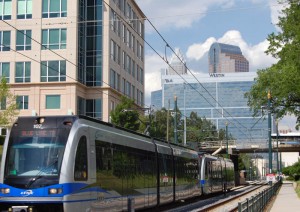
A new pilot program from the Federal Transit Administration will help communities make better use of land around transit lines and stops. For those interested in applying, T4America recently pulled together several experts in a session to help them understand how to best take advantage.
One of the few bright spots in MAP-21 was the creation of this small pilot program of competitive grants for communities trying to support better development within their new transit corridors — a smart way to boost ridership and support local economic development.
With applications due in November, this T4America webinar was timely for those municipalities hoping to take advantage of federal dollars intended to better capitalize on the value of past investments in transit.
Nearly $20 million is available to support transit-oriented development around “fixed guideway” projects, which includes light rail, subway, streetcar, commuter rail, and bus rapid transit running in separate lanes. Grants from $250,000 to $2 million will be allotted to the best applicants from across the country that are focused on mixed-use development, affordable housing, and bicycling/pedestrian needs and have a strong, proven partnership with the private sector.
John Hempelmann, founding partner of Cairncross & Hempelmann, praised the private sector for leading the way on partnerships with transit agencies, realizing that projects like these bring both jobs and economic opportunities to the area.
“Urban growth is happening all over the country. We have this opportunity and we need to do this right.”
Hempelmann also stressed that while the program was over-subscribed, applicants should take heart. Because it’s oversubscribed, he said, it shows the Department of Transportation that local communities want this type of development. And just by applying communities are making progress by working to get private businesses on board and form coalitions. Even for the applications that don’t win funding, these critical partnerships can be of benefit in the future.
It’s not just about partnership with the private sector, though. The U.S. Department of Transportation has made it clear that if a project spans multiple jurisdictions, they want to see partnerships between the communities to show dedication to the project.
Beth Osborne, senior policy advisor for Transportation for America, highlighted the absolute necessity for these kinds of partnerships throughout the community, since it proves to the Department of Transportation that there is not only local interest, but also local support and commitment to the project.
“They want local commitment to the project; people can often be just as important as cash,” Osborne said.
Private and institutional land-owners and developers are critical to the long-term success of transit-oriented development, because they’re the ones most often putting their capital up or building the actual product in these areas around transit lines. Creating partnerships that can do it right offer the greatest opportunities for creating walkable, connected neighborhoods with good access to jobs and affordable housing.
We’ll continue providing similar resources like this webinar, and we’ll be tracking the progress of these applicants and reporting back on the winners hopefully in 2015. To keep updated on these kinds of webinars, sign up for our newsletter here, follow us on twitter, and check back here regularly.
(Ed. Note: Also featured as speakers were Homer Carlisle, Senior Professional Staff for the U.S. Senate Committee on Banking, Housing, and Urban Affairs, and Sarah Kline, policy director for Transportation for America.)
On C-SPAN, T4A’s Beth Osborne finds agreement with Heritage on HTF, walkability


Beth Osborne appearing on C-SPAN July 3, 2014. Click the image or here to watch the full video
Our compatriot Beth Osborne engaged in a spirited discussion on gas taxes and the crashing highway trust fund this morning on C-Span’s Washington Journal. Her co-panelist was Curtis Dubay, taxes and economic policy research fellow at the Heritage Foundation.
Dubay took less of a hard line than have some of his colleagues, who have suggested we could wind down the federal program and make the states take on everything themselves. (As an aside, can you imagine the gory fights in 50 legislatures as they try to raise gas taxes as much as 20 cents a gallon to replace the federal tax, on top of state gas taxes, which some have recently raised? How many legislative sessions would it take, and how many would just punt and let the highways, bridges and transit go to hell?)
As taxes go, Dubay said, the gas tax is a “good one”, because the people who use the resulting system are paying for it. Most people agree that infrastructure in a primary government responsibility. He even agreed a higher tax might be warranted, but only if it is restricted to highway construction.
Dubay complained that the gas tax has been diverted to “non-infrastructure purposes” like subways, ferries and road safety projects that save the lives of pedestrians and bicyclists (and motorists). To which Osborne responded:
Transit is a form of infrastructure. The purpose of the federal program is to move people and goods efficiently, not to require that people move a particular way. From the driver’s perspective it’s just as helpful to get somebody out of their way, particularly [those traveling] short distances. And it can be cheaper to move them outside their cars. … We’re looking for efficiencies and good outcomes in the program. These taxes are being used to move people the way they want to move.
There are lots of good reasons why federal gas tax dollars should be used to build and maintain a truly complete network. Transit projects in major cities make the morning commute possible for drivers, plain and simple, because without it gridlock would be absolute. Federal dollars were used to build roads that cut through neighborhoods without providing for the safety of people walking along or across them, and need to be fixed. Ferries, in states such as Washington, are part of the highway system, connecting roadways across bodies of water. These are not “diversions” from our surface transportation infrastructure; they are key components that must be part of a complete system that offers fair access for all.
In terms of who’s paying the federal gas-tax “user fee”— it’s everybody. You’re not exempt if you only use local roads and no federal highways in your commute. The cost of transporting goods, including gas and diesel taxes, is in the price of everything you buy. In the name of fairness, our taxes should be buying the safest, most efficient, most accessible system possible for all Americans – well-off or poor, young or old, whether living in cities, suburbs or small towns.
Today, market and demographic changes are demanding a new focus for our transportation investments, and that’s because … well, lets give Mr. Dubay the floor:
The market is solving the livability and walkability issue. People are moving in closer to cities. It’s a generational shift… . They are not living in the suburbs as much as they used to, largely because people don’t want to drive like they used to. Having a car and driving isn’t as romantic as it once was, that’s for sure.
If, indeed, people are going to be living in higher concentrations – and they are doing so in both cities and older suburbs – they will still need to get around. What they will need is a seamless, fully integrated network. Many will still own cars and drive them when it makes sense for them, paying gas taxes when they do. They will hope that when they need to use the highway, enough of their fellow residents will be using transit that there is actually room for them on the road.
The local leaders we work with know this, and that’s why they are trying to save the nation’s infrastructure fund from insolvency and win reforms that give them the latitude to do what they need to do. We’re glad to see folks at Heritage acknowledge the changes, and we hope that soon they will join us in declaring an end to the days of the government mandating a top-down, single-mode approach.




